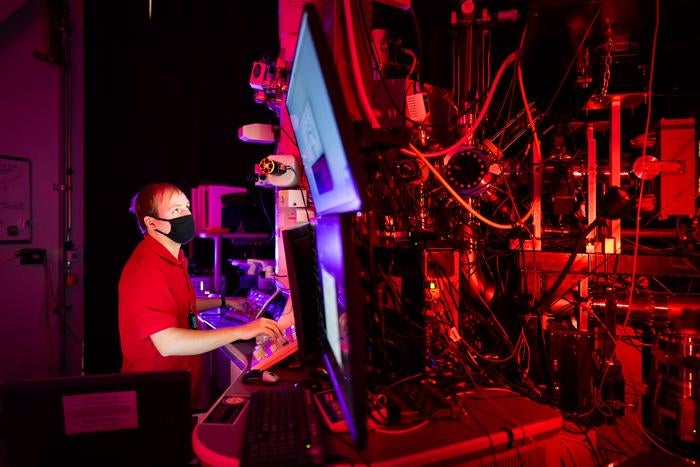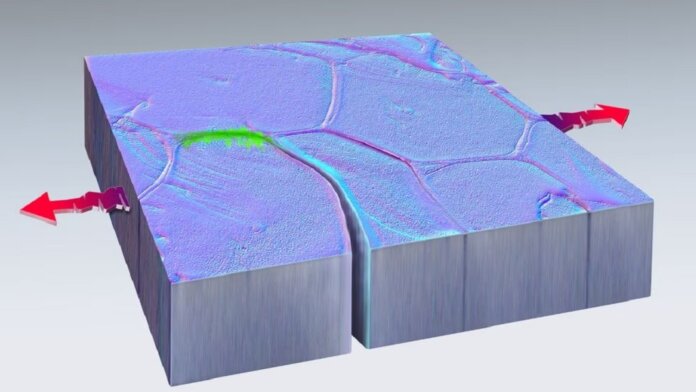If you’ve seen the Terminator movies, you may remember the shape-shifting humanoid robot T-1000. Made of liquid metal, T-1000 could instantly self-heal bullet wounds and other injuries, its metal simply oozing back together and making any damage disappear. Decades after the concept of self-healing metal showed up in a movie, it’s left the realm of pure science fiction and moved closer to reality, as scientists observed metals able to heal themselves for the first time.
In a paper published this week in Nature, a team from Sandia National Laboratories and Texas A&M University described how they were able to see the nanoscale activity of platinum and copper using an electron microscope.
The researchers weren’t actually trying to get the metals to self-heal, and made their discovery essentially by accident. They were working on an experiment meant to see how cracks formed in a piece of platinum, applying a tiny amount of force to it 200 times per second. All of this is happening on a scale that’s only visible through an extremely powerful microscope, giving “tiny” a new meaning.
As Sandia staff scientist and paper co-author Brad Boyce put it, “These films that we’re looking through are vanishingly thin—they’re a handful of atoms, so the forces you need to apply to such a thin film before it rips apart are hard to relate to. Think of one mosquito’s leg—that’s the type of force we’re applying.”
As the researchers watched for new cracks to form, they saw the opposite happen: one end of an existing crack fused back together. Though it later re-formed in a different direction, the initial damage disappeared. “Cracks in metals were only ever expected to get bigger, not smaller. Even some of the basic equations we use to describe crack growth preclude the possibility of such healing processes,” Boyce said.

The metal’s self-healing happened through a process called cold welding, caused by a combination of local stress state and grain boundary migration. The latter refers to defects in the metals’ crystalline structure. When force is applied the defects move, and their movement creates a compressive stress that activates the metal’s cold-welding capabilities.
Because the experiment was done at the nanoscale, the researchers isolated the metal film in a vacuum to make sure atmospheric atoms wouldn’t affect the results. Figuring out whether the metals’ self-healing capability is lost under non-vacuumous conditions will be one of the big questions the researchers look into in subsequent experiments. “We show this happening in nanocrystalline metals in vacuum,” Boyce said. “But we don’t know if this can also be induced in conventional metals in air.”
While the research won’t have any immediate real-world applications, it could have several important ones down the road. The repeated stress put on metal structures, from bridges to turbines, wear them down and make it necessary to replace parts regularly. If self-healing could be integrated into new metallic materials, it could make a big difference in how well structures hold up over time.
“From solder joints in our electronic devices to our vehicle’s engines to the bridges that we drive over, these structures often fail unpredictably due to cyclic loading that leads to crack initiation and eventual fracture,” Boyce said. “When they do fail, we have to contend with replacement costs, lost time and, in some cases, even injuries or loss of life. The economic impact of these failures is measured in hundreds of billions of dollars every year for the US.”
While there won’t be any T-1000s walking around anytime soon (thank goodness), metal that’s able to self-heal could improve the safety of multiple components of our daily lives and save us time and money.
“What we have confirmed is that metals have their own intrinsic, natural ability to heal themselves, at least in the case of fatigue damage at the nanoscale,” Boyce said. “This was absolutely stunning to watch first-hand.”
Image Credit: Dan Thompson/Sandia National Laboratories



